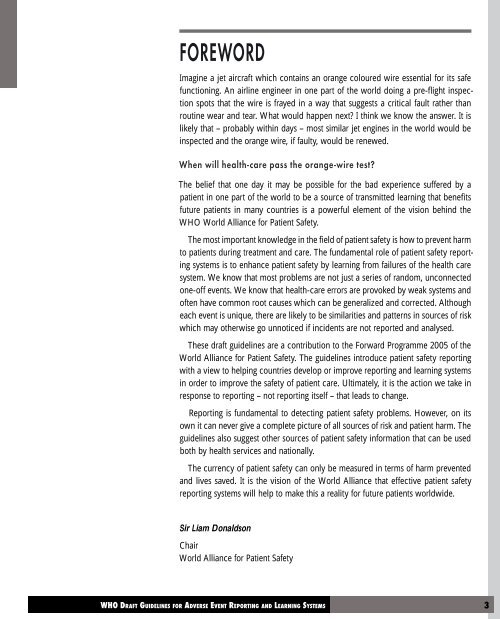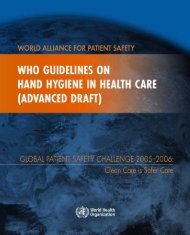Adverse event reporting.pdf
Adverse event reporting.pdf
Adverse event reporting.pdf
Create successful ePaper yourself
Turn your PDF publications into a flip-book with our unique Google optimized e-Paper software.
FOREWORD<br />
Imagine a jet aircraft which contains an orange coloured wire essential for its safe<br />
functioning. An airline engineer in one part of the world doing a pre-flight inspection<br />
spots that the wire is frayed in a way that suggests a critical fault rather than<br />
routine wear and tear. What would happen next? I think we know the answer. It is<br />
likely that – probably within days – most similar jet engines in the world would be<br />
inspected and the orange wire, if faulty, would be renewed.<br />
When will health-care pass the orange-wire test?<br />
The belief that one day it may be possible for the bad experience suffered by a<br />
patient in one part of the world to be a source of transmitted learning that benefits<br />
future patients in many countries is a powerful element of the vision behind the<br />
WHO World Alliance for Patient Safety.<br />
The most important knowledge in the field of patient safety is how to pr<strong>event</strong> harm<br />
to patients during treatment and care. The fundamental role of patient safety <strong>reporting</strong><br />
systems is to enhance patient safety by learning from failures of the health care<br />
system. We know that most problems are not just a series of random, unconnected<br />
one-off <strong>event</strong>s. We know that health-care errors are provoked by weak systems and<br />
often have common root causes which can be generalized and corrected. Although<br />
each <strong>event</strong> is unique, there are likely to be similarities and patterns in sources of risk<br />
which may otherwise go unnoticed if incidents are not reported and analysed.<br />
These draft guidelines are a contribution to the Forward Programme 2005 of the<br />
World Alliance for Patient Safety. The guidelines introduce patient safety <strong>reporting</strong><br />
with a view to helping countries develop or improve <strong>reporting</strong> and learning systems<br />
in order to improve the safety of patient care. Ultimately, it is the action we take in<br />
response to <strong>reporting</strong> – not <strong>reporting</strong> itself – that leads to change.<br />
Reporting is fundamental to detecting patient safety problems. However, on its<br />
own it can never give a complete picture of all sources of risk and patient harm. The<br />
guidelines also suggest other sources of patient safety information that can be used<br />
both by health services and nationally.<br />
The currency of patient safety can only be measured in terms of harm pr<strong>event</strong>ed<br />
and lives saved. It is the vision of the World Alliance that effective patient safety<br />
<strong>reporting</strong> systems will help to make this a reality for future patients worldwide.<br />
Sir Liam Donaldson<br />
Chair<br />
World Alliance for Patient Safety
















